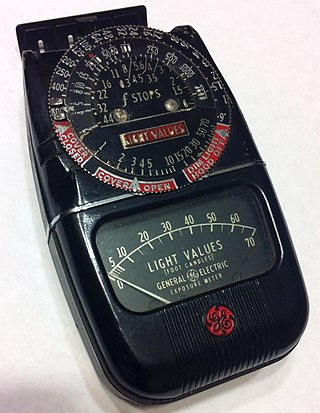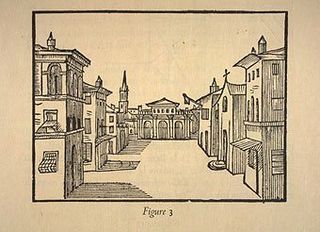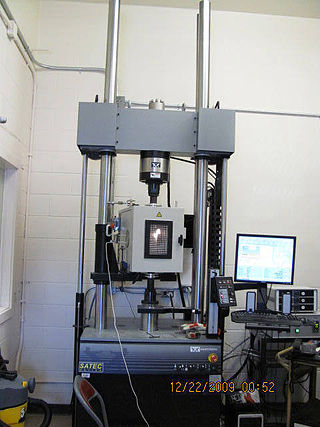Related Research Articles

Brightness is an attribute of visual perception in which a source appears to be radiating or reflecting light. In other words, brightness is the perception elicited by the luminance of a visual target. The perception is not linear to luminance, and relies on the context of the viewing environment.

Daylighting is the practice of placing windows, skylights, other openings, and reflective surfaces so that direct or indirect sunlight can provide effective internal lighting. Particular attention is given to daylighting while designing a building when the aim is to maximize visual comfort or to reduce energy use. Energy savings can be achieved from the reduced use of artificial (electric) lighting or from passive solar heating. Artificial lighting energy use can be reduced by simply installing fewer electric lights where daylight is present or by automatically dimming or switching off electric lights in response to the presence of daylight – a process known as daylight harvesting.

The Kruithof curve describes a region of illuminance levels and color temperatures that are often viewed as comfortable or pleasing to an observer. The curve was constructed from psychophysical data collected by Dutch physicist Arie Andries Kruithof, though the original experimental data is not present on the curve itself. Lighting conditions within the bounded region were empirically assessed as being pleasing or natural, whereas conditions outside the region were considered uncomfortable, displeasing or unnatural. The Kruithof curve is a sufficient model for describing sources that are considered natural or closely resemble Planckian black bodies, but its value in describing human preference has been consistently questioned by further studies on interior lighting.

Lighting or illumination is the deliberate use of light to achieve practical or aesthetic effects. Lighting includes the use of both artificial light sources like lamps and light fixtures, as well as natural illumination by capturing daylight. Daylighting is sometimes used as the main source of light during daytime in buildings. This can save energy in place of using artificial lighting, which represents a major component of energy consumption in buildings. Proper lighting can enhance task performance, improve the appearance of an area, or have positive psychological effects on occupants.

A foot-candle is a non-SI unit of illuminance or light intensity. The foot-candle is defined as one lumen per square foot. This unit is commonly used in lighting layouts in parts of the world where United States customary units are used, mainly the United States. Nearly all of the world uses the corresponding SI derived unit lux, defined as one lumen per square meter.

Window coverings are considered any type of materials used to cover a window to manage sunlight, privacy, additional weatherproofing or for purely decorative purposes.

Architectural lighting design is a field of work or study that is concerned with the design of lighting systems within the built environment, both interior and exterior. It can include manipulation and design of both daylight and electric light or both, to serve human needs.

Rembrandt lighting is a standard lighting technique that is used in studio portrait photography and cinematography; it is also used in contrast with butterfly lighting It can be achieved using one light and a reflector, or two lights, and is popular because it is capable of producing images which appear both natural and compelling with a minimum of equipment. Rembrandt lighting is characterized by an illuminated triangle under the eye of the subject on the less illuminated side of the face. It is named for the Dutch painter Rembrandt, who occasionally used this type of lighting.

Nicola Sabbatini, also known as Niccolò Sabbatini or Nicola Sabbattini, was an Italian architect of the Baroque.

Building Science is the science and technology-driven collection of knowledge to provide better indoor environmental quality (IEQ), energy-efficient built environments, and occupant comfort and satisfaction. Building physics, architectural science, and applied physics are terms used for the knowledge domain that overlaps with building science. In building science, the methods used in natural and hard sciences are widely applied, which may include controlled and quasi-experiments, randomized control, physical measurements, remote sensing, and simulations. On the other hand, methods from social and soft sciences, such as case study, interviews & focus group, observational method, surveys, and experience sampling, are also widely used in building science to understand occupant satisfaction, comfort, and experiences by acquiring qualitative data. One of the recent trends in building science is a combination of the two different methods. For instance, it is widely known that occupants' thermal sensation and comfort may vary depending on their sex, age, emotion, experiences, etc. even in the same indoor environment. Despite the advancement in data extraction and collection technology in building science, objective measurements alone can hardly represent occupants' state of mind such as comfort and preference. Therefore, researchers are trying to measure both physical contexts and understand human responses to figure out complex interrelationships.
Radiance is a suite of tools for performing lighting simulation originally written by Greg Ward. It includes a renderer as well as many other tools for measuring the simulated light levels. It uses ray tracing to perform all lighting calculations, accelerated by the use of an octree data structure. It pioneered the concept of high-dynamic-range imaging, where light levels are (theoretically) open-ended values instead of a decimal proportion of a maximum or integer fraction of a maximum. It also implements global illumination using the Monte Carlo method to sample light falling on a point.

Holophane, a division of Acuity Brands, is a manufacturer of lighting-related products founded in 1898 in London, England. The company is a UK-based and US manufacturer of lighting fixtures for commercial, industrial, outdoor, and emergency applications. The company is noted for its glass reflector/refractor. In addition, it manufactures lenses for street lights, including General Electric, Cooper Lighting, and Lithonia Lighting. Holophane has been integral in the Illuminating Engineering Society of North America since its inception in 1906, with the first meeting being held in the headquarters.
The lambert is a non-SI metric unit of luminance named for Johann Heinrich Lambert (1728–1777), a Swiss mathematician, physicist and astronomer. A related unit of luminance, the foot-lambert, is used in the lighting, cinema and flight simulation industries. The SI unit is the candela per square metre (cd/m2).

Glare is difficulty of seeing in the presence of bright light such as direct or reflected sunlight or artificial light such as car headlamps at night. Because of this, some cars include mirrors with automatic anti-glare functions and in buildings, blinds or louvers are often used to protect occupants. Glare is caused by a significant ratio of luminance between the task and the glare source. Factors such as the angle between the task and the glare source and eye adaptation have significant impacts on the experience of glare.
George S. Sexton, III is an American designer, specializing in the areas of lighting design, museum design and museum planning services.
The Illuminating Engineering Society (IES), is an industry-backed, not-for-profit, learned society that was founded in New York City on January 10, 1906. The IES's stated mission is "to improve the lighted environment by bringing together those with lighting knowledge and by translating that knowledge into actions that benefit the public".
Light ergonomics is the relationship between the light source and the individual. Poor light can be divided into the following:
Focus Lighting is a New York City based architectural lighting design firm founded by Paul Gregory in 1987.
The Chicago Lighting Institute was an educational and marketing association serving the lighting industry in the Midwest. The main aim of the institute was to acquaint architects, interior designers, electrical engineers, urban planners and the general public with the latest developments and applications in lighting. It was the first U.S. institution to promote appropriate use of light in the earlier years of the lighting industry.
Climate based daylight modelling (CBDM) also known as dynamic daylight metrics is a calculation methodology first developed in the late 1990s to assess daylight quality and quantity. It is used by Building Design engineers and architects to predict luminance and/or illuminance within buildings using standardised sun and sky condition climate data for a given geographical location. It is a different design metric to Daylight factors which only considers the ratio of the light level inside a structure to the light level outside the structure from an overcast sky. With CBDM, if used considerately, the facade design of a building can be optimised to maximise useful daylight whilst excluding excessive daylight, which otherwise might cause issues with glare, visual discomfort, and/or solar gains which can cause thermal comfort issues. At the same time reducing reliance and operation of artificial lighting. CBDM calculations are calculated within Building simulation modelling software tools for each and every hour of the year, or sometimes for smaller increments, which allows for daily and seasonal profiles to be tested and optimised
References
- ↑ Visual Comfort and Productivity, tristate.apogee.net; retrieved February 16, 2014 via Wayback Machine
- ↑ Ward, G.J. (1991). "RADIANCE Visual Comfort Calculation". Rapport Interne, LESO, EPFL.
- ↑ Guth, SK (1963). "A method for the evaluation of discomfort glare". Illuminating Engineering. 58 (5): 351–364.
- ↑ Guth, Sylvester K. (October 1966). "Computing Visual Comfort Ratings For a Specific Interior Lighting Installation" (PDF). Illuminating Engineering: 634–642.